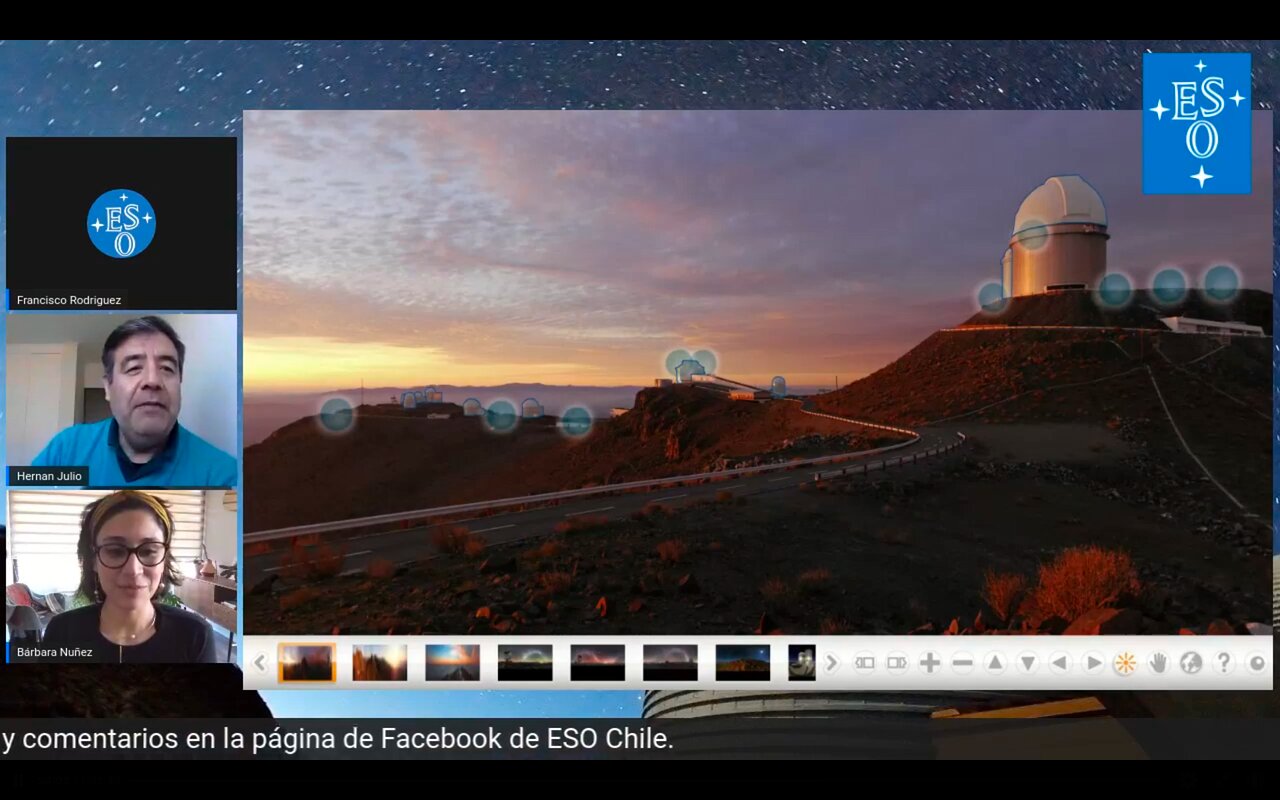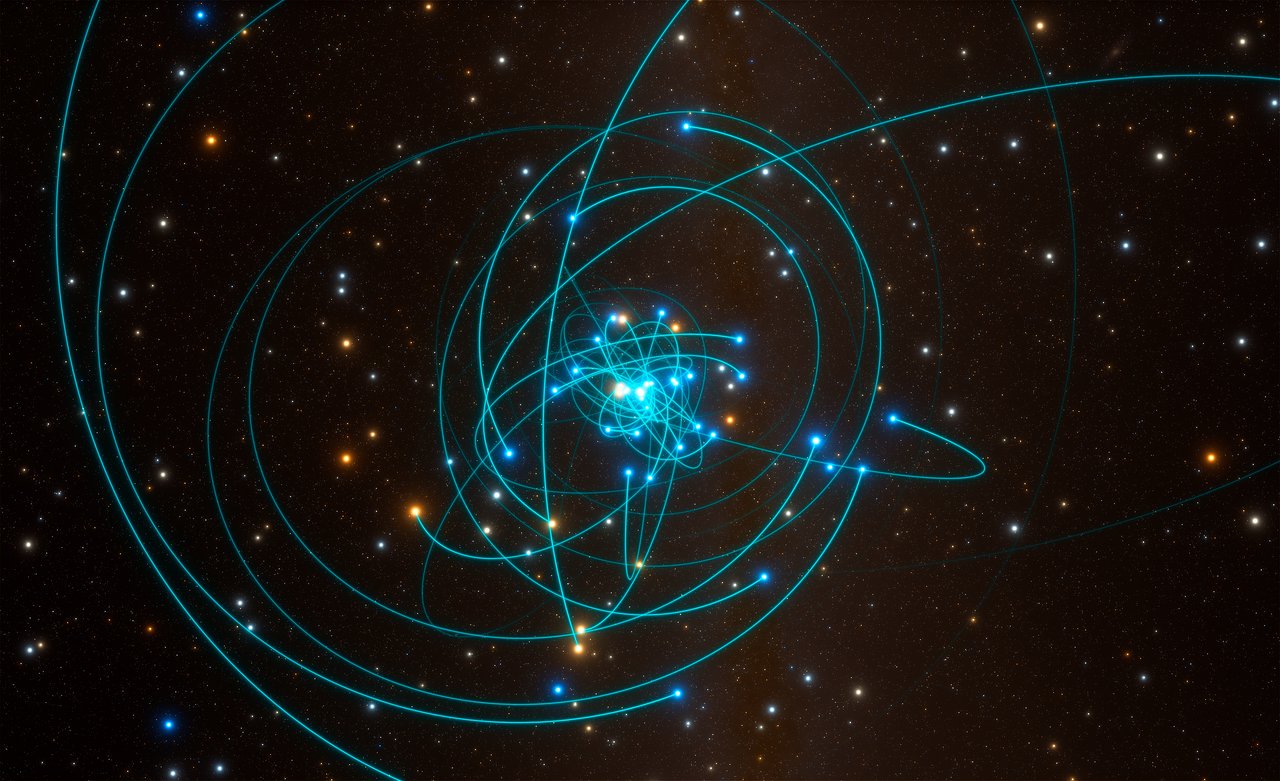- Discover some of ESO’s media highlights from 2020
- Relive some of our most popular images and stories from the year
The launch of virtual tours
During this year, public tours of the ESO observatories in Chile were halted due to the ongoing pandemic. In response, ESO got creative and launched new virtual tours of the observatories led by our specialised guides. These regular tours stream live on ESO’s Facebook and YouTube in both English and Spanish, allowing anyone to explore iconic locations at ESO’s observatories and ask questions to our guides. You can find the schedule of upcoming tours on our Facebook and Twitter using the #TourESO hashtag.
Most viewed Picture of the Week
Every Monday, ESO selects one image as its Picture of the Week, including photos of ESO’s sites, telescopes and images created using ESO data. In 2020, the most visited Picture of the Week on ESO’s website was ‘Death by Laser?’.
What appears to be a terrible cosmic weapon in this image is in fact the four orange laser beams from ESO’s Very Large Telescope (VLT) shooting into the atmosphere. These laser beams are part of the VLT’s cutting edge Adaptive Optics Facility, helping measure the blurring effects of the Earth’s atmosphere. The laser beams are directed towards the Carina Nebula, among the largest in the southern sky, which appears as a vast pink cloud of gas and dust in this image.
You can share your images of ESO sites and data from our telescopes on our Flickr page.
Most read ESOblog post
The most read ESOblog post of 2020 investigated what ESO’s Extremely Large Telescope (ELT) will reveal about the Universe. This post featured an interview with ELT Programme Scientist Michele Cirasuolo where he discusses how the ELT is a giant technological leap forward, that is only possible due to lessons learnt building ESO’s VLT and technology developed using it, and what new discoveries the ELT may make.
The sheer size of ESO’s ELT (its main mirror is 39 metres across, compared to 8.2 metres for each unit telescope of the VLT) offers exciting scientific possibilities. The ELT can act as a window into what the Universe was like in the cosmic dark ages, 13 billion years ago, by starting to resolve objects in the very distant Universe. The enormous light collecting power of the ELT will also allow astronomers to really start characterising exoplanet atmospheres to see whether they may be suitable for life and perhaps find new Earths. However, what Michele finds most exciting about the ELT is the potential for discoveries that are completely unexpected that allow us to ask new questions that previously we hadn’t thought of.
Most liked image on Instagram
ESO’s Instagram page presents some of the stunning and significant images related to its science and operations. In 2020, the most popular image on ESO’s Instagram looked back on the stunning view of the total solar eclipse seen at ESO’s La Silla Observatory one year earlier. This rare event, lasting for less than two minutes, coincided with the 50th anniversary of the observatory.
During a total solar eclipse the path of the Moon passes in front of the Sun, overlapping perfectly and blocking out most of its light. This event is only possible as the Moon’s distance from the Earth means it happens to appear the same size in the sky as the Sun.
Most viewed announcement
Aside from the rolling announcement on COVID-19 safety measures taken by ESO, the most viewed announcement this year was the Milestones Reached in Incredible Journey of ELT Main Mirror Segments. At 39 metres across, the main mirror of ESO’s ELT is too large to be crafted from a single piece of glass. The main mirror will instead be composed of 798 hexagonal segments each 1.4 metres across and 5 cm thick, which must be precisely engineered to work as one giant mirror and deliver unprecedented astronomical data. A number of new milestones important for creating the centrepiece of the ELT were discussed, including the inauguration of the ELT polishing facility in Poitiers, France. Here, the round mirror segment blanks are ground and polished to level them to an accuracy of tens of nanometres. Segments are then cut into the hexagonal shape and even more precisely polished.
Most popular photo press release
Images of systems with multiple planets are very rare. Back in July, ESO announced that for the first time, multiple planets had been directly observed around a star like our Sun. Observations from this study, led by Alexander Bohn from the University of Exeter, and others can help astronomers understand how planets formed and evolved around our own Sun.
The above image captured by the SPHERE instrument on ESO’s VLT shows the star TYC 8998-760-1 (in the top left corner) accompanied by its two giant exoplanets. The image was captured by blocking most of the light from the young, Sun-like star using a coronagraph, which allows the fainter planets to be seen but causes artefacts (the bright and dark rings around the star). This system is very different from our own, with the inner and outer planets fourteen and six times heavier than Jupiter respectively. The below video shows that these planets are much more distant from their star than Pluto is from the Sun.
Most watched ESOcast
The most watched ESOcast video this year accompanied the press release on Death by Spaghettification, explaining how a star is ripped apart and devoured by a black hole. Researchers led by Matt Nicholl from the University of Birmingham, UK, pointed ESO’s VLT and ESO’s New Technology Telescope at the rare blast of light caused by this violent event, 215 million light-years from Earth, finding it can launch a powerful blast of material outwards. The full artist’s animation of the star being devoured can be watched here. This and other videos from ESO can be viewed on our YouTube channel.
Most popular organisational release
A new study commissioned by ESO to evaluate the impact of 18 satellite constellations on astronomical observations was released in March, becoming ESO’s most popular organisational release of 2020. Astronomers were concerned by what impact the satellite mega-constellations under development by SpaceX, OneWeb and others would have on scientific research.
The study found that ESO’s VLT and future ELT would be ‘moderately affected’ by these 26 000 satellites, especially for long exposures between sunset and dusk. However, wide field surveys, especially by larger telescopes like the US National Science Foundation's Vera C. Rubin Observatory, would see up to 30% to 50% of exposures "severely affected”, depending on the time of night and other factors.
A conversation has since started between astronomers, engineers and satellite companies to try to mitigate the effects of satellite mega-constellations, as reported in this announcement in August. The astronomical community can help by identifying ways to lower satellite brightness and developing software to mask satellite trails or calculate satellite paths to avoid them. Satellite operators could launch fewer satellites, and reduce how much light they reflect by changing satellite altitudes and darkening spacecraft or using sunshades. SpaceX are now deploying a sunshade on all new Starlink satellites to reduce their visibility on the night sky though they will remain detectable by even small observatories.
Most popular press release
ESO’s most popular press release of 2020 across the internet announced, in May, the discovery of the closest black hole to Earth so far. Lying just 1000 light-years from Earth, this black hole forms part of a triple system, and is also the first where its two companion stars can be seen by the naked eye. The team, led by ESO scientist Thomas Rivinius, were analysing their observations of what was believed to be the double-star system HR 6819, and were stunned to discover a third object: a black hole. Using the FEROS spectrograph on the MPG/ESO 2.2-metre telescope at ESO’s La Silla Observatory showed that one of the two visible stars orbits an unseen object, at least four times more massive than our Sun, every 40 days. The video below shows the system, with the second star orbiting the inner pair on a longer period.
The system can be seen by the naked eye from the southern hemisphere within the constellation of Telescopium on a dark, clear night. The team believe this system could be the tip of the iceberg and help provide clues where many hidden black holes in the Milky Way could be.
Finally, a Nobel Prize
Last in this roundup, the 2020 Nobel Prize in Physics was partly awarded to Reinhard Genzel, who has worked in collaboration with ESO developing instruments for around 30 years, for his work on the supermassive black hole, Sagittarius A*, at the centre of our galaxy. Genzel, Director at the Max Planck Institute for Extraterrestrial Physics in Germany, shares half of the prize with Andrea Ghez, a professor at the University of California, Los Angeles in the US, "for the discovery of a supermassive compact object at the centre of our galaxy".
Both Genzel, using ESO telescopes, and Ghez, with the Keck telescopes in Hawaii, have conducted observations to track the orbits of stars at the centre of the Milky Way and enable insight into Sagittarius A*. Specifically, by tracking a star named S2, Genzel’s team found the light it emitted was stretched to longer wavelengths, confirming for the first time Einstein’s predictions of the effects of general relativity near a supermassive black hole. The ELT’s higher angular resolution will allow astronomers to probe the behaviour of stars even closer to the black hole in future, and take testing relativity to another level.
We hope you enjoyed this blog post rounding up media highlights from ESO in 2020. We’re looking forward to more fantastic astronomy images and results in the new year!
Numbers in this article
| 17 | ESOcasts |
| 19 | Press releases |
| 22 | ESOblog posts |
| 36 | Announcements |
| 52 | Pictures of the Week |
| 120 | Instagram images |
Links
- All information on the most popular stories and images is valid up to the beginning of December 2020. You can find the latest ESO press releases and announcements on our website.










